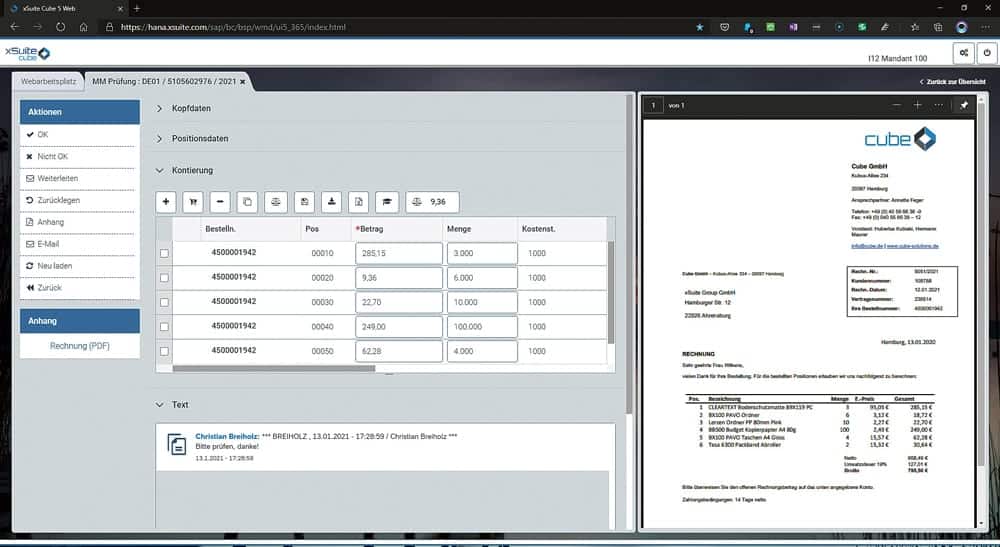Procure-to-Pay


Added to this are increased compliance requirements and the issue of different company locations or even the need to work from home. Digitization and automation provide a remedy here.
Purchasing is already quite far along in this respect: According to a recent study by the German Association of Materials Management, Purchasing and Logistics (BME), two-thirds of companies will have almost completely automated their operational purchasing processes in the medium term. If we add invoice verification and payment processes to this, we are talking about procure-to-pay, or P2P for short, i.e., end-to-end processes ranging from the creation of a requisition to audit-proof invoice storage.
Not only paperless
In SAP Business Suite or with S/4 Hana, it should be possible to carry out such holistic P2P workflows as directly as possible within the system. However, this does not mean that they are automatically completely paperless. Often, the processes are much less digital or automated in detail than one would expect.
This is also because purchasing and accounting departments are well organized and paper processes have already been optimized to the extreme. Thanks to skilled staff who are adept and thorough, process flows are also largely secured.
But in the longer term, efficient work will basically only be possible if operational business processes are fully digitized and automated. SAP-integrated workflow and process solutions such as those from the xSuite Group can do this. They ensure that document-based processes are mapped in SAP in an end-to-end automated manner.
This accelerates and simplifies processes, improves work results and makes it easier to achieve set targets. Purchasing and accounting experience a significant reduction in workload. Numerous starting points for digitization and automation can be found in the many small-scale, operational work steps that occur throughout the P2P process. This includes the people, departments and workflows involved.
In requirements recording, for example. This is where every procurement process begins. In practice, this means that anyone who needs a product or service either fills out a form or informally asks a higher authority whether they can initiate the procurement process. This is where the first challenge arises: You have to know who is responsible. This could be a supervisor, department management, or the person responsible for the cost center or budget.
It is not uncommon for an informal inquiry, for example by e-mail, not to contain all the information that Purchasing needs. This means that queries regularly arise. If there is a paper request form, the chances are better that all relevant information will be recorded directly, but this also brings with it all the disadvantages of paper: The authorized signatory must physically get hold of the document and cannot flexibly carry out both the approval and the forwarding to Purchasing at any time and from anywhere.
Move away from copy-and-paste
In the next step, after hopefully not too long a wait and many queries, the request goes to purchasing. This department must transfer the data to the SAP system so that an order can be generated. Depending on the form of the inquiry, this is called copy-and-paste or manual typing. If there are no further points to be clarified or missing approvals, the purchase order can be triggered in SAP. It is either printed out and sent by mail or possibly already digitally as a PDF by e-mail to the supplier.
This is a lengthy process that can be shortened with a workflow solution. The request is then created digitally, either via a web client or an SAP Fiori app. For the experienced SAP user, it is also possible to enter the request directly in the SAP GUI. Purchasing benefits from this, because the requisition is already received digitally and all information is standardized and centrally available: no more time-consuming, manual gathering of information, no more annoying queries. The next steps - forwarding the request for review or approval - can also be automated using workflow.
After release, the requisition is automatically sent to Purchasing, which checks it; the system then automatically generates the purchase order from the requisition in the background. Further manual steps are no longer necessary; the order can be sent to the supplier.
The next step in the P2P process is for the supplier to respond to the order with an order confirmation. This is another point where digitization and automation come into their own. First, the data from the incoming confirmation can be automatically transferred to SAP.
This applies equally to paper-based and digital documents, from PDF to XML files. Document reading technology captures confirmation data from documents and transfers it to the appropriate field in the SAP system. Manual typing or copy-and-paste are eliminated.
An automation solution can also take over the content check and play out (color-highlighted) warnings if a value from the confirmation deviates from the order. This makes verification much easier.

Discover and eliminate time-consuming routines
The next step that can be digitally automated is the processing of incoming invoices. These arrive digitally or in paper form, at a central location or to the attention of a specific person. Similar to the processing of incoming order confirmations, there are also various options for automation here. These include reading the data from the invoice and transferring it to the SAP fields provided for this purpose. This eliminates a time-consuming routine activity. All that remains is for the processor to check and validate the results of the document reading.
For invoices with a purchase order reference, the content comparison can also be automated. The software checks whether the details of the invoice and the purchase order match and whether the goods receipt or the service entry has already been posted. If this is the case, there is a so-called 3-way match. This ensures a particularly high level of security: everything is correct. Manual reconciliation between these three points is no longer necessary, the process is fully automated and errors or attempted fraud are almost always detected at an early stage.
For the accounting department, this reduces the effort dramatically, if not to zero. Checking the 3-way match in the manual process is very time-consuming and thus hardly feasible in practice. If, on the other hand, the P2P processes are digitized, this check can be performed automatically. A workflow solution thus significantly increases the security of the processes.
Even if there is no purchase order reference, many steps in the processing of an incoming invoice can be automated. Data entry into the SAP system can also be automated in this case using document reading and data extraction technology. Manual typing is no longer necessary; only a validation step needs to take place to ensure that the software has read and transferred everything correctly.
Automated testing and approval
There is further potential for optimization in the review and approval processes. Several people are always involved in these processes, usually from different departments. Digitization and automation eliminate the need to transport documents from one desk to the next, which shortens processing times.
On the other hand, a digital workflow ensures compliance with release guidelines and processes because these are stored in the system. As a result, they can no longer be circumvented, be it when entering requirements or when ordering, checking and approving an invoice. Together with the reminder function and automatic logging and archiving, the software also relieves employees of some process discipline.
Many work steps can therefore be automated across the entire P2P process chain. The necessary prerequisites for this are the digitization of incoming documents, the extraction of data from them and their automatic transfer to the ERP system. This works for incoming order confirmations as well as for invoices. Result in each case: A great deal of manual effort for typing the data is eliminated.
In addition to saving time and effort, there are of course other tangible reasons for workflow-supported automation of P2P processes: greater transparency, better evaluability for discovering optimization potential, and higher security. There are even direct monetary benefits, for example in the form of cash discounts: Because automation leads to faster processing, which in turn enables suppliers to be paid earlier.




